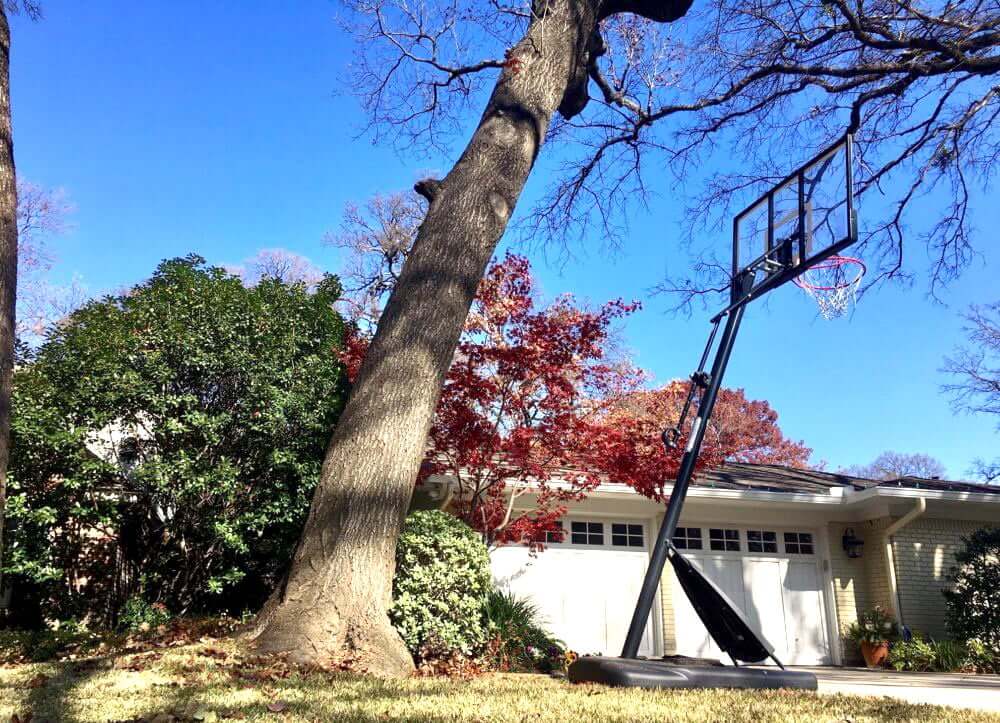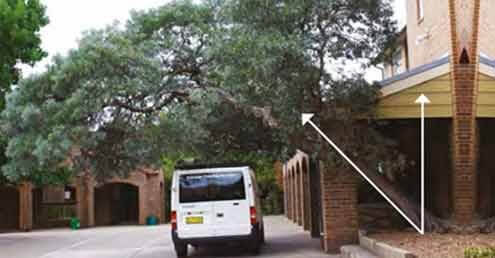A tree that is leaning poses significant risks. Nonetheless, the degree of danger is largely contingent upon the cause behind the tree’s inclination.
A tree will lean when it is growing toward a light source. A lean can also develop where there are consistent low-blowing winds that gradually force leaning as a result of the low pressure that they create. And it can also happen due to soil erosion, a compromised root structure, or extremely strong winds. Physical trauma from mechanical impact, having a weak trunk, or the presence of an unbalanced canopy, are also common causes of leaning.
Here is what you should know about leaning trees.

What we cover
ToggleThe most common reason for tree leaning
The following are the most common reasons why trees lean.
Soil or root issue
A tree can lean simply because of a poor root structure or soft soil.
If a tree is growing in an area with a poor soil structure, it can develop a lead after consistent rain and wind. It may also be that the soil hampers root penetration because it is too hard or rocky, and this may lead to poor root support.
If a large tree develops a lean overnight, you need to get a risk assessment from a local tree surgeon.
Growing towards light
A tree that is growing under a shade is also prone to leaning1. This happens as the tree tries to compete for light. Whether it is a larger tree in its way or an obstructive structure, the tree will try to find a way out of the shadow. And as it tries to position itself in a way that it gets enough sunlight, it will end up leaning.

Outside damage
Sometimes, the tree leans because its structure has been compromised through physical damage.
Storms are a major cause of leaning trees. When they partially uproot trees, they cause them to lean.
Physical trauma as a result of being bumped by construction equipment or vehicles can also cause a tree to lean. And so can any physical damage that is inflicted on its roots.
Growth habits
Trees with weak trunks lean simply because the trunk does not have the structural integrity to support its weight. An unbalanced canopy can also cause a tree to lean. Such a canopy consistently exerts weight on one side. And as the tree grows, the constant pressure may gradually cause it to start leaning toward that direction. This happens especially if the tree has a weak tree trunk.
Are leaning trees dangerous?
Yes, a leaning tree can be dangerous if it develops suddenly, but if the tree has grown that way from day one, it should be fairly structurally sound as reactionary growth of roots and the trunk help support the tree’s unusual form.
Whichever the case, if you are unsure, you are best getting a risk assessment2 from a local certified arborist. Some precautionary measures such as relieving some weight from the canopy can help stabilize the tree without complete removal.
Are tree experts able to pull the tree back?
Yes, tree experts are able to stabilize3 leaning trees to some extent depending on the size of the tree.
They can physically pull it back and then give it extra structural support through cabling and bracing. Trimming a tree with the aim of balancing its canopy can sometimes get rid of a lean. Therefore, it is something that arborists do in cases where a tree is leaning due to an unbalanced canopy.
However, if the tree leaning occurs naturally — like when growing towards sunlight — then there is little that an arborist can do. This is so especially if the tree adopted the leaning over an extended period.
Can neighboring trees act as a shield to a leaning tree?
Yes, neighboring trees can act as a shield to a leaning tree if it were to fail.
And in cases where the leaning is a result of extensive soil erosion, the presence of neighboring trees tends to reduce the degree to which the soil’s integrity gets compromised hence tempering the severity of the leaning.
FAQ's
It is OK for a tree to lean if it grows that way, but if it develops a lean overnight, something is seriously wrong.
This is because it typically implies that the tree has become structurally unsound for whatever reason.
The following are the steps for fixing small leaning trees. If the tree is larger than 3m I suggest you call an arborist for assistance.
- Start by driving a stake next to the tree. Make sure that you drive it at an angle — an angle of approximately 45 degrees away from the tree’s stem is recommended.
- With the stake properly anchored, it is now time to straighten the tree. Loosen the soil around the tree by soaking it with water. And then apply steady pressure on the tree to straighten it
- After getting the tree in a straight position, firm the soil around it by tamping it. Firmly pack the root into the ground to such a point where the tree is relatively stable.
- The last step is to secure the tree into position. If the tree is small, use burlap or canvas strips to tie them to the stake. Nylon can also be used.
And if it is a larger tree, then using a cable or a rope will be ideal. If you choose to use either of these, threading the cable or rope through a garden hose is always advisable. This is because it usually helps to prevent bark and trunk damage.
Leave the stakes in place for at least a season. This is so as to give the tree’s roots enough time to anchor before removing the supporting stakes.
You should be concerned about a leaning tree in the following circumstances.
- If the tree leaning starts after a storm or any other extreme weather event, then you should be concerned. This is because leaning in such circumstances usually means that a tree has been partially uprooted, or that its stem has been significantly damaged.
- On observing past photographs of the tree, if you notice that the leaning is getting worse, then you should definitely be concerned as it means that the underlying cause of the leaning is still present.
- Cracking or heaving of soil at the base of the tree should also be a cause of concern. This is because it indicates that the tree’s base is gradually getting dislodged.
- Increasing root exposure usually translates to worsening structural support for the tree. And so if the tree’s leaning was a result of extreme soil erosion or root damage and you are noticing that the tree’s roots are increasingly getting exposed, then it is time to start getting worried.
- You should also be concerned about any leaning tree that carries a higher risk of causing damage or injury. This applies to trees that are located in sections with high traffic or those that are located near valuable structures or homes.
You can stabilize a tree by bracing it, staking it, guying it, or cabling it. Planting it in more tree-friendly soil that supports root penetration, can also help.
Staking is the best way to train a young tree to grow straight.
To do this, sink a stake into the ground. Then firmly attach the tree to the stake by tying it with a rope or wire.
To avoid injuring the tree, it is always advisable to avoid tying the wire or rope directly on the tree’s trunk. Instead, you should use rubber or a piece of cloth to attach the stem to the wire or rope.
- Leaf and Limb Tree Services, (2023) Why Is My Tree Leaning? <https://leafandlimbtreeservices.com/blog/why-is-my-tree-leaning> Accessed: 01-03-2024.
- Leaf and Limb Tree Services, (2023) Are Leaning Trees Dangerous? Assessing the Safety of Your Trees <hhttps://leafandlimbtreeservices.com/blog/are-leaning-trees-dangerous/> Accessed: 01-03-2024.
- Scott A Sjolander, Brian Wolyniak, (2023) What to Do About Leaning Trees. <https://extension.psu.edu/what-to-do-about-leaning-trees> Accessed: 01-03-2024.




